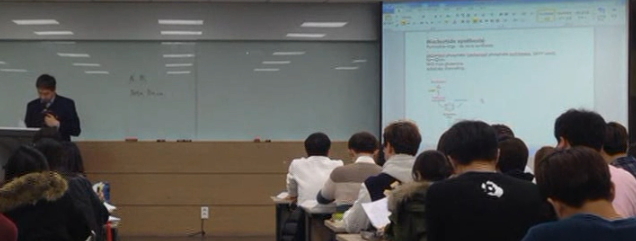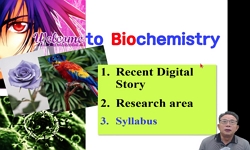The study investigated the effect of diets supplemented with different levels (0 and 2.5%) of yuza (Citrus junos Sieb ex Tanaka) on the nutritional characteristics of eels (Auguilla japonica). Fish (9.8±1.3 g) was fed to apparent satiation twice dail...
http://chineseinput.net/에서 pinyin(병음)방식으로 중국어를 변환할 수 있습니다.
변환된 중국어를 복사하여 사용하시면 됩니다.
- 中文 을 입력하시려면 zhongwen을 입력하시고 space를누르시면됩니다.
- 北京 을 입력하시려면 beijing을 입력하시고 space를 누르시면 됩니다.

유자 첨가 사료로 사육한 뱀장어의 영양학적 특성 = Nutritional Characteristics of Eels (Auguilla japonica) Fed a Diet of Yuza (Citrus junos Sieb ex Tanaka)
한글로보기https://www.riss.kr/link?id=A103871719
- 저자
- 발행기관
- 학술지명
- 권호사항
-
발행연도
2010
-
작성언어
Korean
-
주제어
Eel ; Yuza ; Amino acid ; Sugar ; Organic acid ; Fatty acid ; Eel ; Yuza ; Amino acid ; Sugar ; Organic acid ; Fatty acid
-
등재정보
KCI등재
-
자료형태
학술저널
- 발행기관 URL
-
수록면
573-580(8쪽)
-
KCI 피인용횟수
5
- DOI식별코드
- 제공처
-
0
상세조회 -
0
다운로드
부가정보
다국어 초록 (Multilingual Abstract)
The study investigated the effect of diets supplemented with different levels (0 and 2.5%) of yuza (Citrus junos Sieb ex Tanaka) on the nutritional characteristics of eels (Auguilla japonica). Fish (9.8±1.3 g) was fed to apparent satiation twice daily for 8 months. There were no significant differences in proximate composition among the treatment groups, except for the ash and carbohydrate contents (P<0.05). The vitamin C content of eel muscle in the yuza-added group was two-times higher than in non-added groups (P<0.05). Among eight organic acids in eel muscle, lactic acid was predominant, followed by citric acid, oxalic acid, malic acid, and acetic acid. Eels fed a 2.5% yuza diet had the highest lactic acid content in all groups. Six sugars were found in all groups and glucose was the major sugar. Glucose and maltose were the dominant sugars in the yuza-added group. The abundant fatty acids in the yuza-added group were C18:1 n-9, C16:0, and C16:1 n-7, which comprised over 80% of the total fatty acids. The major amino acids in samples were glutamic acid, aspartic acid, lysine, and leucine. There were few differences in the free amino acid compositions among the groups. However, histidine was the predominant amino acid and constituted over 53% of the total free amino acids.
참고문헌 (Reference)
1 전민지, "자연산 뱀장어의 채집지역 및 크기에 따른 체성분의 영양학적 특성" 한국양식학회 16 (16): 273-278, 2003
2 김흥윤, "유자 첨가 사료로 사육된 넙치의 휘발성 향미 성분" 한국수산과학회 42 (42): 224-231, 2009
3 김흥윤, "유자 첨가 사료로 사육된 넙치의 영양성분" 한국수산과학회 42 (42): 215-223, 2009
4 김진도, "오매, Prunus mume 추출물 투여에 따른 뱀장어, Anguilla japonica의 면역 반응과 성장" 한국어병학회 22 (22): 367-374, 2009
5 정관식, "습사료에 비타민 C와 E 첨가가 넙치 치어의 성장과 체성분에 미치는 영향" 한국수산과학회 36 (36): 100-106, 2003
6 배준영, "사료내 맥반석과 BAISM 복합첨가가 치어기 뱀장어 Anguilla japonica의 성장과 내병성에 미치는 영향" 한국양식학회 21 (21): 26-33, 2008
7 김진도, "Yeast β-glucan 첨가 사료가 뱀장어의 비특이적 면역 반응에 미치는 영향" 한국어병학회 21 (21): 219-228, 2008
8 Yoo KM, "Variation in major an antioxidants and total antioxidant activity of yuza(Citrus junos Sieb ex Tanaka) during maturation and between cultuvars" 52 : 5907-5913, 2004
9 Halver JE, "Utilization of ascorbic acid in fish" 258 : 81-102, 1975
10 Thompson I, "The effect of stress on the immune response of Atlantic salmon(Salmo salar L.) fed diets containing different amounts of vitamin C" 114 : 1-18, 1993
1 전민지, "자연산 뱀장어의 채집지역 및 크기에 따른 체성분의 영양학적 특성" 한국양식학회 16 (16): 273-278, 2003
2 김흥윤, "유자 첨가 사료로 사육된 넙치의 휘발성 향미 성분" 한국수산과학회 42 (42): 224-231, 2009
3 김흥윤, "유자 첨가 사료로 사육된 넙치의 영양성분" 한국수산과학회 42 (42): 215-223, 2009
4 김진도, "오매, Prunus mume 추출물 투여에 따른 뱀장어, Anguilla japonica의 면역 반응과 성장" 한국어병학회 22 (22): 367-374, 2009
5 정관식, "습사료에 비타민 C와 E 첨가가 넙치 치어의 성장과 체성분에 미치는 영향" 한국수산과학회 36 (36): 100-106, 2003
6 배준영, "사료내 맥반석과 BAISM 복합첨가가 치어기 뱀장어 Anguilla japonica의 성장과 내병성에 미치는 영향" 한국양식학회 21 (21): 26-33, 2008
7 김진도, "Yeast β-glucan 첨가 사료가 뱀장어의 비특이적 면역 반응에 미치는 영향" 한국어병학회 21 (21): 219-228, 2008
8 Yoo KM, "Variation in major an antioxidants and total antioxidant activity of yuza(Citrus junos Sieb ex Tanaka) during maturation and between cultuvars" 52 : 5907-5913, 2004
9 Halver JE, "Utilization of ascorbic acid in fish" 258 : 81-102, 1975
10 Thompson I, "The effect of stress on the immune response of Atlantic salmon(Salmo salar L.) fed diets containing different amounts of vitamin C" 114 : 1-18, 1993
11 Yang ST, "Taste Compounds of Fresh-Water Fishes.7.Tastes Compounds of Wild Eel Meat.Bull Kor Fish Soc 17,33-39" 17 : 33-39, 1984
12 Calabro ML, "Study of the extraction procedure by experimental design and validation of a LC method for determination of flavonoids in Citrus bergamin juice" 35 : 349-363, 2004
13 Lee KH, "Statistics and Data Analysis Method" Hyoil Press 253-296, 1998
14 Kang EJ, "Species Identification of Japanese, American, and European Eel Elvers, and Changes in Morphmetric Characters According to Growth" 12 : 244-249, 2000
15 Park YH, "Processing of the Sea Food" Hyungsul Press 166-168, 1997
16 AOAC, "Official Method of Analysis of the Association of Official Analytical Chemistes, 17th ed" AOAC 2000
17 Hong SP, "Mineral Contents and Fatty Acid Composition in Bone and Flesh of Cultured Eel" 20 : 98-102, 2005
18 유경미, "In vitro 상에서 유자(Citrus junos SIEB ex TANAKA) 용매 추출물의 암세포 억제효과 및 항산화성" 한국식품과학회 36 (36): 339-344, 2004
19 Shou H, "Food component and taste" 16 : 83-87, 1969
20 Bai SC, "Development of an Experimental Model for Vitamin C Requirement Study in Korean Rockfish, Sebastes schlegeli" 9 : 169-178, 1996
21 Kim HY, "Comparison of The Taste Compounds of Wild and Cultured Eel, Puffer and Snake head" 32 : 1058-1067, 2000
22 Choi JH, "Comparative Study on Protein and Amino Acid Composition of Wild and Cultured Eel" 19 : 60-66, 1986
23 Cha JY, "Biofunctional activities of citrus flavonoids" 44 : 122-128, 2001
24 Yoo KM, "Antioxant activities and anticancer effects of Yuza (Citrus junos)" 38 : 72-77, 2005
25 Kim SG, "A study on the consumption pattern of aquacultured marine fishes" 34 : 53-73, 2003
26 Folch J, "A Simple Method for the Isolation and Purification of Total Lipid from Animal Tissues" 226 : 497-509, 1957
동일학술지(권/호) 다른 논문
-
- 한국수산과학회
- 이소정
- 2010
- KCI등재
-
- 한국수산과학회
- 문수경
- 2010
- KCI등재
-
배합사료의 소맥분 함량이 곳체다슬기, Semisulcospira gottschei의 성장 및 체조성에 미치는 영향
- 한국수산과학회
- 김경덕
- 2010
- KCI등재
-
갈조류 감태 (Ecklonia cava Kjellman)의 대량양식을 위한 가이식 및 양성 조건
- 한국수산과학회
- 황은경
- 2010
- KCI등재
분석정보
인용정보 인용지수 설명보기
학술지 이력
| 연월일 | 이력구분 | 이력상세 | 등재구분 |
|---|---|---|---|
| 2026 | 평가예정 | 재인증평가 신청대상 (재인증) | |
| 2020-01-01 | 평가 | 등재학술지 유지 (재인증) |  |
| 2017-01-01 | 평가 | 등재학술지 유지 (계속평가) |  |
| 2014-08-06 | 학술지명변경 | 외국어명 : Korean Journal of Fisheries and Aquatic Sciences -> Korean Journal of Fisheries and Aquatic Sciences |  |
| 2013-01-01 | 평가 | 등재학술지 유지 (계속평가) |  |
| 2010-01-01 | 평가 | 등재학술지 유지 (등재유지) |  |
| 2009-09-04 | 학회명변경 | 한글명 : 한국수산학회 -> 한국수산과학회영문명 : The Korean Fisheries Society -> The Korean Society of Fisheries and Aquatic Science |  |
| 2009-07-03 | 학술지명변경 | 한글명 : 한국수산학회지 -> 한국수산과학회지외국어명 : Journal of The Korean Fisheries Society -> Korean Journal of Fisheries and Aquatic Sciences |  |
| 2008-01-01 | 평가 | 등재학술지 유지 (등재유지) |  |
| 2006-01-01 | 평가 | 등재학술지 유지 (등재유지) |  |
| 2003-01-01 | 평가 | 등재학술지 선정 (등재후보2차) |  |
| 2002-01-01 | 평가 | 등재후보 1차 PASS (등재후보1차) |  |
| 1999-07-01 | 평가 | 등재후보학술지 선정 (신규평가) |  |
학술지 인용정보
| 기준연도 | WOS-KCI 통합IF(2년) | KCIF(2년) | KCIF(3년) |
|---|---|---|---|
| 2016 | 0.47 | 0.47 | 0.43 |
| KCIF(4년) | KCIF(5년) | 중심성지수(3년) | 즉시성지수 |
| 0.43 | 0.43 | 0.59 | 0.17 |




 ScienceON
ScienceON






